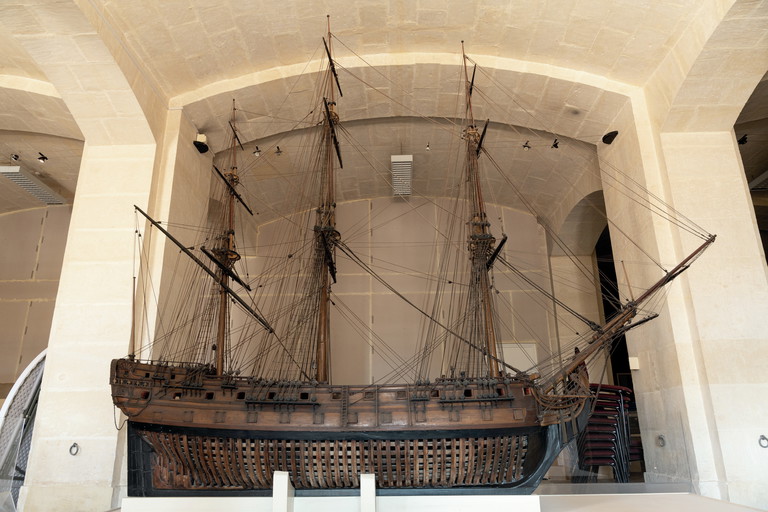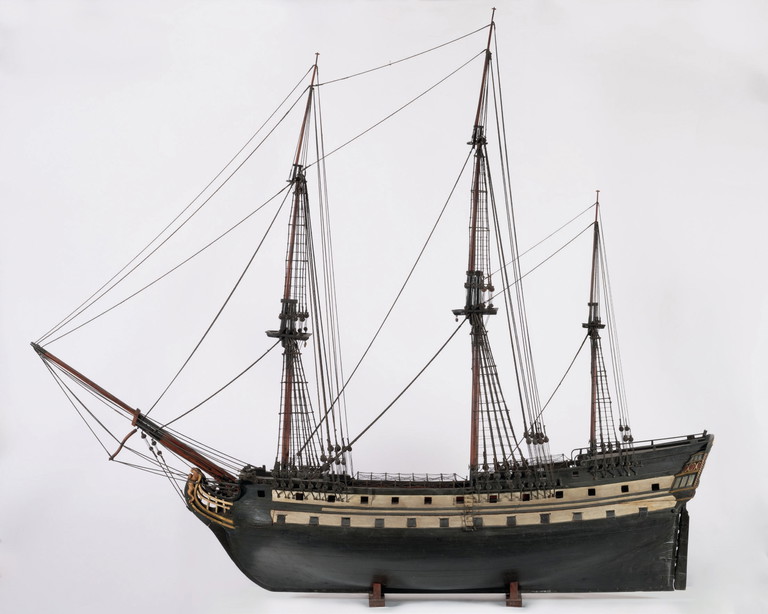
Two Vaxxelli Instruction Models
The Ships of the Line
The Order of St. John’s Nautical school was established in the old university building on Merchant Street. There, apart from a host of navigational equipment and instruments, were a number of instruction models. The only known items to survive pertaining to the school are two instruction models both of third-rate ships of the line preserved at the Malta Maritime Museum dating to the mid-18th century. One is known as the “Working Vaxxell instruction model” and the other as the “Exploding Vaxxell instruction model”.
The latter model seems to be the older of the two and its creator still eludes researchers. The term “exploding model” refers to a genre of models where one can take them apart into several pieces, deck by deck, to learn and become acquainted with the ship’s decks, their sections and divisions and the general overall setup of the ship. This model, made entirely of wood with hemp and metal fittings, is extremely interesting not just because of the divisions, sections and compartments within, but also for its iconic decoration.
The ships forming the Maltese Vaxxelli squadron are documented to have sported two types of figureheads, either an Order’s allegory (termed as Malta nowadays), or a rampant lion. Practically all European navies sported a lion figurehead, some crowned, some rampant, others growling. But the Maltese lion rampant figurehead has an infidel’s head clenched in its front paws, which no other European navy dared to sport. This model, 1.6m in length, has survived fairly well, possibly missing its spars, and has never required major restoration efforts.
The other Vaxxell model, 3m in length, is one of the most awe-inspiring items in the Malta Maritime Museum. Made of wood, it has had a troubled history and had to undergo a heavy restoration in an attempt to save it for posterity in the 1960s. It is made entirely of wood with metal fittings and hemp rigging, the latter totally redone during the restoration, whilst most of the woodwork and metal fittings remain original except for the spares. An 18th century diary describes how the model was inaugurated in 1772 at the former Jesuit college, and unveiled in the presence of Grand Master Pinto, who commissioned the model. This was to serve as an instruction model at the new nautical school. Thanks to this model, newly appointed or aspiring officers could instruct themselves on how the Vaxxelli functioned. The running rigging actually works, the yard arms swing, anchors can be hauled and lowered and the rudder moves. Each order to be imparted by the officer was followed by the presumed sailors by pulling the correct rope on the model for better maneuverability. There and then, the result would have been noted by the instructor and any fault on the part of the student addressed.
The contents of the Order’s nautical school were dispersed in as yet uncertain circumstances and dates. The notable Doctor Salvatore Luigi Pisani had acquired these two models at some time and eventually bequeathed them together with several other collections to the museum early in the 20th century. Two attempts were made to restore this model in the late 1920s with limited success.
The third-rate ships of the line (Vaxxelli) squadron were introduced by Grand Master Ramon Perellos y Rocaful (1697-1720) in 1700. This type of ‘modern’ war ship was believed to be a much better vessel then galleys. The Maltese Vaxxelli being third rates usually carried 56 cannon on two decks. A whole new set up was required for the building and maintenance of such a squadron. In April 1702, the Order began building the squadron’s new stores at Bormla and the macina, a crane onto one of Senglea’s bastions necessary for the new squadron. Meanwhile, the four ships forming the new squadron were being built. Two were being constructed at Toulon, France, bearing the names of San Giovanni and San Giacomo, whilst the two being built in Malta were named Santa Caterina and San Giuseppe, the latter a frigate intended with 40 guns.
The first ever success of the squadron was achieved in 1706 when the 50-gun Rosa di Tunisi was captured and after repairs, pressed into service with the other four Vaxxelli as the Santa Croce. Malta was thus abreast of other European navies, boasting two naval squadrons, that of the modern Vaxxelli and the older trusted and feared galleys. The Vaxxelli squadron operated until June 1798 when Malta fell to Napoleon with its last recorded victory achieved just less than two months before. The Vaxxelli squadron had never registered a lost ship and was always victorious. It was honoured by all of Europe, surpassing similar and even larger squadrons belonging to much mightier European city states.
